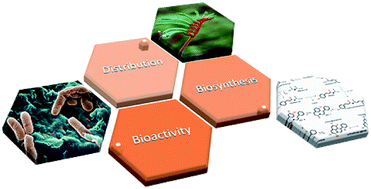Distribution, biosynthesis, and biological activity of phenylphenalenone-type compounds derived from the family of plants, Haemodoraceae
Abstract
Covering: up to 2018
The Haemodoraceae family is a monocotyledonous family in the order Commelinales consisting of 14 genera. Many species from the family are endemic to Australia and their use by the Aboriginal People of Australia as both pigments or remedies has been ethnobotanically documented. Phenylphenalenones are phenolic specialised metabolites consisting of a tricyclic phenalene nucleus with a ketone moiety and a lateral phenyl ring. Depending on their structural variance, four classes can be distinguished including the phenylphenalenones, oxabenzochrysenones, phenylbenzoisochromenones and phenylbenzoisoquinolinediones. The phenylphenalenone class has become the order's chemotaxonomic marker with a documented range of biological activities. This biological activity arises from the phototoxic properties of their ring system, a phenomenon most comprehensively observed amongst a widely cultivated family of the Commelinales order, Musaceae (banana). Within the family Haemodoraceae, the formation of the phenylphenalenone-class phytoanticipins is an intrinsic function of their growth, whereas within the family Musaceae these compounds are formed as phytoalexins in response to pathogenic attack or stress. The compounds produced within these two families differ in their substitution, with Musaceae-derived phytoalexins tending to be the more phototoxic 4-phenylphenalenones and the Haemodoraceae-derived phytoanticipins being of the more inert 9-phenylphenalenone type structure. Various other substitution patterns have been documented across the class, yet their biosynthetic mechanism is consistent, proceeding from simple phenylpropanoids through a diarylheptanoid intermediate, which cyclises to form the phenylphenalenone nucleus. Phenylphenalenone-related compounds have also been observed within the fungal kingdom, yet their biosynthetic route is based upon an alternative polymalonate pathway. This review focuses on Haemodoraceae-derived phenylphenalenone-type compounds, their distribution amongst species, throughout the plant organism, their biological activity and their biosynthesis.



 Please wait while we load your content...
Please wait while we load your content...